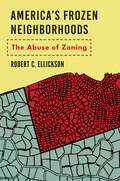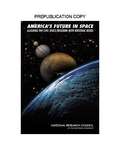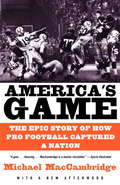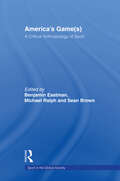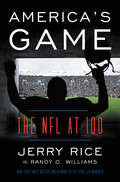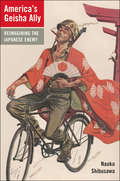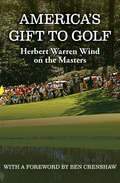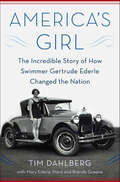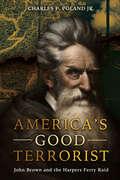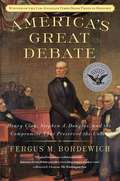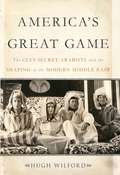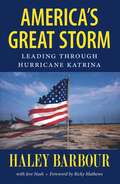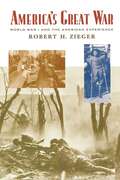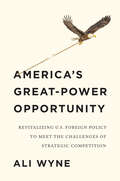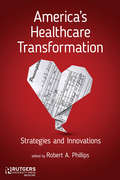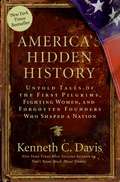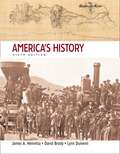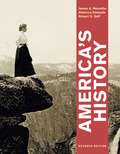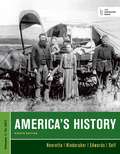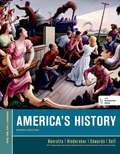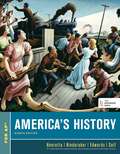- Table View
- List View
America's Frozen Neighborhoods: The Abuse of Zoning
by Robert C. EllicksonThis book examines local zoning policies and suggests reforms that states and the federal government might adopt to counter the negative effects of exclusionary zoning In this book, Robert Ellickson asserts that local zoning policies are the most consequential regulatory program in the United States. Many localities have created barriers to the development of less costly forms of housing. Numerous economists have found that current zoning practices inflict major damage on the national economy. Using Silicon Valley, the Greater New Haven area, and the northwestern portion of Greater Austin as case studies, Ellickson shows in unprecedented detail how the zoning system works and recommends steps for its reform. Zoning regulations, Ellickson demonstrates, are hard to dislodge once localities have enacted them. He develops metrics to measure the existence and costs of exclusionary zoning, and suggests reforms that states and the federal government could undertake to counter the detrimental effects of local policies. These include the cartelization of housing markets and the aggravation of racial and class segregation.
America's Future in Space: Aligning the Civil Space Program with National Needs
by National Research Council of the National AcademiesAs civil space policies and programs have evolved, the geopolitical environment has changed dramatically. Although the U.S. space program was originally driven in large part by competition with the Soviet Union, the nation now finds itself in a post-Cold War world in which many nations have established, or are aspiring to develop, independent space capabilities. Furthermore discoveries from developments in the first 50 years of the space age have led to an explosion of scientific and engineering knowledge and practical applications of space technology. The private sector has also been developing, fielding, and expanding the commercial use of space-based technology and systems. Recognizing the new national and international context for space activities, America's Future in Space is meant to advise the nation on key goals and critical issues in 21st century U.S. civil space policy.
America's Game
by Michael MaccambridgeIt's difficult to imagine today--when the Super Bowl has virtually become a national holiday and the National Football League is the country's dominant sports entity--but pro football was once a ramshackle afterthought on the margins of the American sports landscape. In the span of a single generation in postwar America, the game charted an extraordinary rise in popularity, becoming a smartly managed, keenly marketed sports entertainment colossus whose action is ideally suited to television and whose sensibilities perfectly fit the modern age.America's Game traces pro football's grand transformation, from the World War II years, when the NFL was fighting for its very existence, to the turbulent 1980s and 1990s, when labor disputes and off-field scandals shook the game to its core, and up to the sport's present-day preeminence. A thoroughly entertaining account of the entire universe of professional football, from locker room to boardroom, from playing field to press box, this is an essential book for any fan of America's favorite sport.From the Trade Paperback edition.n scope, America's Game is cultural history at its finest. A thoroughly entertaining account of the entire universe of professional football, from locker room to boardroom, from playing field to press box, it is a unique lens through which to view the past sixty years of American history.From the Hardcover edition.
America's Game: A Critical Anthropology of Sport (Sport in the Global Society)
by Benjamin Eastman, Michael Ralph and Sean BrownThis insightful volume considers how to locate America in the sporting world: in the traditions and rituals of a national pastime or in the baseball academies run by American professional teams in the Dominican Republic? With the athletes that carry a flag in Olympic ceremonies or among the executives in the boardrooms of Nike? The contributors arg
America's Game: The NFL at 100
by Jerry Rice Randy O. WilliamsA celebration of 100 years of the NFL from Hall of Fame receiver and bestselling author Jerry Rice!“This book is an amazing compilation of the game’s history as seen through the eyes of my friend Jerry Rice, aka The GOAT. You are going to love this book almost as much as you loved watching Jerry play!” —Barry Sanders, NFL Hall of Fame Class of 2004The authors of the New York Times bestseller 50 Years, 50 Moments celebrate the first 100 years of the National Football League, interweaving history, personal stories, memories, and observations of some of its greatest players, coaches, and advocates to chronicle football’s amazing evolution from a fledgling regional fly-by-night operation into a multi-billion global brand and one of America’s leading franchises.Over the past century, professional football has transformed from a game played in leather helmets on cow pastures to one of the most high-tech, popular sports on the planet. In this entertaining and concise history, Jerry Rice and Randy O. Williams celebrate the NFL’s centennial, bringing together colorful memories, insights, and personal experiences and observations from the heroes, losers, innovators, and defining legends who have played the game at its highest level. America's Game is filled with inside stories of the league’s fiercest rivalries, closest competitions, and most memorable characters, from the early days of Red “The Galloping Ghost” Grange and “Slingin’” Sammy Baugh to Jim Brown and “Broadway” Joe Namath to Lawrence Taylor, Jerry Rice, and Tom Brady.Cowboy fans will never forget how Roger Staubach’s Hail Mary lifted his team to a last-second playoff victory over the Vikings. Patriot followers will always point to The Tuck Rule Game as a franchise landmark where Adam Vinatieri’s two clutch kicks in deep snow propelled his team to victory over the Raiders. Generations of Steelers fans will celebrate James Harrison’s electrifying 100–yard interception return for a touchdown in Super Bowl XLIII. All are among the most memorable moments in NFL history. Divided by increments of twenty-five years, each section of America's Game includes the authors’ selections for their “All Star” players and teams.America's Game is a unique tribute to this enduring cultural phenomenon, and will become the authoritative tribute to all that is great about the sport Americans—and the world—loves.
America's Geisha Ally
by Naoko ShibusawaDuring World War II, Japan was vilified by America as our hated enemy. As the Cold War heated up, however, the U.S. government decided to make Japan its bulwark against communism in Asia. In this revelatory work, Naoko Shibusawa charts the remarkable reversal from hated enemy to valuable ally that occurred in the two decades after the war.
America's Gift to Golf: Herbert Warren Wind on the Masters
by Herbert Warren WindThe dean of American golf writers pays tribute to the nation&’s greatest tournament Over the course of his forty-year career at the New Yorker and Sports Illustrated, Herbert Warren Wind covered the game of golf from many different angles, providing readers with eloquent insights on the iconic courses of Scotland as well as Bing Crosby&’s lifelong love affair with the sport. But no aspect of golf was closer to Wind&’s heart, or more intimately associated with his name, than the annual Masters Tournament at Augusta National Golf Course. Recounting Arnold Palmer&’s victory in 1958, Wind coined the phrase &“Amen Corner&” to describe the fateful stretch of golf course including the 11th, 12th, and 13th holes. To celebrate the fiftieth anniversary of the first Augusta National Invitation, held in 1934, Wind eloquently recounted a half-century&’s worth of highlights, from Bobby Jones&’s original vision of an informal competition between his old friends and the game&’s rising stars, to Ben Crenshaw&’s impressive defeat of Tom Watson in the 1984 tournament. Full of the grand traditions—including green jackets, purple azaleas, and white jumpsuits—and dramatic moments that have made the Masters the most entertaining of the four major championships, America&’s Gift to Golf brings the history of this majestic tournament to vivid life and testifies to the enduring legacy of Herbert Warren Wind.
America's Girl: The Incredible Story of How Swimmer Gertrude Ederle Changed the Nation
by Tim Dahlberg Mary Ederle Ward Brenda GreeneAmerica's Girl is an intimate look at the life and trials of Gertrude Ederle, who in 1926 not only became the first woman to swim across the English Channel, but broke the record set by men. The feat so thrilled America that it welcomed her home with a ticker tape parade that drew two million people. This fascinating portrait follows Ederle from her early days as a competitive swimmer through her gold medal triumph at the 1924 Olympics, to the first attempt the next year by Ederle to swim from France to England in frigid and turbulent waters, a feat that had been conquered by only five men up to that time. This is also a stirring look at the go-go era of the 1920s, when the country was about to recognize that women not only could vote, but compete on an international scale as athletes. At the height of Prohibition, Ederle's triumph over the formidable Channel was a triumph for women everywhere. America's Girl immerses readers in a pivotal era of American history and brings to life the spirit of that time.
America's Good Terrorist: John Brown and the Harpers Ferry Raid
by Charles P. Poland Jr.<p>A biography of John Brown, examining his failed raid on Harpers Ferry, and the part his actions played in causing the Civil War.<p> <p>John Brown’s failed efforts at Harpers Ferry have left an imprint upon our history, and his story still swirls in controversy. Was he a madman who felt his violent solution to slavery was ordained by Providence or a heroic freedom fighter who tried to liberate the downtrodden slave? These polar opposite characterizations of the violent abolitionist have captivated Americans. The prevailing view from the time of the raid to well into the twentieth century—that his actions were the product of an unbalanced mind—has shifted to the idea that he committed courageous acts to undo a terrible injustice.<p> <p>Despite the differences between modern terrorist acts and Brown’s own violent acts, when Brown’s characteristics are compared to the definition of terrorism as set forth by scholars of terrorism, he fits the profile. Nevertheless, today Brown is a martyred hero who gave his life attempting to terminate the evil institution of human bondage. The modern view of Brown has unintentionally made him a “good terrorist,” despite the repugnance of terrorism that makes the thought of a benevolent or good terrorist an oxymoron.<p> <p>This biography covers Brown’s background and the context to his decision to carry out the raid, a detailed narrative of the raid and its consequences for both those involved and America; and an exploration of the changing characterization of Brown since his death.<p>
America's Got Democracy!: The Making of the World's Longest-Running Reality Show
by Danny KatchA humorous but passionate look at the criminal silliness of the US political system from the author who has &“better comic bomb sights than John Stewart&” (Mike Davis, author of The Monster at Our Door). In this raucous, irreverent book, Danny Katch diagnoses the various mental disorders peculiar to those who have way too much money and power—and the politicians who work for them. He shows how the very elections that are supposed to be our way of bringing about change have become a tool to get us to accept the insane status quo. &“The funniest, smartest, and most dangerous political writer you never heard of is Danny Katch. You&’ll laugh. You&’ll get pissed off. You&’ll disagree. And you&’ll wonder how you read this terrific book in one sitting. A welcome antidote to what passes for political writing in an election year.&” —Dave Zirin, author of Game Over: How Politics Has Turned the Sports World Upside Down &“From Cocoa Puffs to melting ice caps, Danny Katch&’s America&’s Got Democracy gets to the heart of how and why our political establishment creates economic, social, and environmental crapification, and he does it with a flair even the most disaffected café barista with a PhD will love. But if you enjoy reading dry, abstract political works in which the words go clopping across the page on little wooden feet, don&’t read Katch&’s book.&” —Sherry Wolf, author of Sexuality and Socialism &“Guess what? It&’s even more boringer reading it than talking about it.&” —Lila Katch, seven years old
America's Great Debate: Henry Clay, Stephen A. Douglas, and the Compromise That Preserved the Union
by Fergus M. BordewichThe Mexican War introduced vast new territories into the United States, among them California and the present-day Southwest. When gold was discovered in California in the great Gold Rush of 1849, the population swelled, and settlers petitioned for admission to the Union. But the U.S. Senate was precariously balanced with fifteen free states and fifteen slave states. Up to then states had been admitted in pairs, one free and one slave, to preserve that tenuous balance in the Senate. Would California be free or slave? So began a paralyzing crisis in American government, and the longest debate in Senate history. Fergus Bordewich tells the epic story of the Compromise of 1850 with skill and vigor, bringing to life two generations of senators who dominated the great debate. Luminaries such as John Calhoun, Daniel Webster, and Henry Clay—who tried unsuccessfully to cobble together a compromise that would allow for California’s admission and simultaneously put an end to the nation’s agony over slavery—were nearing the end of their long careers. Rising stars such as Jefferson Davis, William Seward, and Stephen Douglas—who ultimately succeeded where Clay failed—would shape the country’s politics as slavery gradually fractured the nation. The Compromise saved the Union from collapse, but it did so at a great cost. The gulf between North and South over slavery widened with the strengthened Fugitive Slave Law that was part of the complex Compromise. In America’s Great Debate Fergus Bordewich takes us back to a time when compromise was imperative, when men swayed one another in Congress with the power of their ideas and their rhetoric, when partisans on each side reached across the aisle to preserve the Union from tragedy.
America's Great Game: The CIA's Secret Arabists and the Shaping of the Modern Middle East
by Hugh WilfordThe Central Intelligence Agency’s reputation in the Middle East today has been marred by waterboarding and drone strikes, yet in its earliest years the agency was actually the region’s staunchest western ally. In America's Great Game, celebrated intelligence historian Hugh Wilford reveals how three colorful CIA operatives-Kermit and Archie Roosevelt, and maverick covert-ops expert Miles Copeland-attempted, futilely, to bring the U. S. and Middle East into harmony during the 1940s and '50s. Heirs to an American missionary tradition that taught them to treat Arabs and Muslims with respect and empathy, these CIA "Arabists” nevertheless behaved like political puppet-masters, orchestrating coup plots throughout the Middle East while seeking to sway public opinion in America against support for the new state of Israel. Their efforts, and ultimate failure, would doom U. S. -Middle Eastern relations for decades to come. Drawing on extensive new material, including declassified government records, private papers, and personal interviews, America's Great Game shows how three well-intentioned spies inadvertently ruptured relations between America and the Arab world.
America's Great Railroad Stations
by Roger Straus IIIAn evocative and stunning photographic tribute to America's railroad stations. For much of the nineteenth and early twentieth centuries, the railroad station or depot was the communal hub of every American town that could boast of train service. There, citizens gathered before they sent loved ones off to college, marriage, or war-and where they greeted them on their return. Most of these buildings were architectural gems, and while many are still in service, certain others now house museums, banks, restaurants, and more. In fact, in cities like Washington, D. C. , and Philadelphia, renovated stations are destinations unto themselves even for those not boarding the train. And in other places, whole sections of towns have been remade around these structures, restoring their vitality in novel and interesting ways long after the last train has left the station. In America's Great Railroad Stations, award-winning photographer Roger Straus III, and two lifelong railroad buffs, Ed Breslin and Hugh Van Dusen, join forces to tell the astonishing story of these enduring structures and the important role they still play in the country's landscape. Journeying from the Pennsylvania Railroad to the Union Pacific to Michigan Central and more, readers will be dazzled by the Beaux Arts monuments of New York and the adobe buildings of the Southwest. Filled with both new and archival photographs and drawings, this volume is a glorious salute to the institution that transformed our nation. .
America's Great Storm: Leading through Hurricane Katrina
by Haley BarbourWhen Hurricane Katrina hit Mississippi on August 29, 2005, it unleashed the costliest natural disaster in American history, and the third deadliest. Haley Barbour had been Mississippi's governor for only twenty months when he assumed responsibility for guiding his pummeled, stricken state's recovery and rebuilding efforts. America's Great Storm is not only a personal memoir of his role in that recovery, but also a sifting of the many lessons he learned about leadership in a time of massive crisis. For the book, the authors interviewed more than forty-five key people involved in helping Mississippi recover, including local, state, and federal officials as well as private citizens who played pivotal roles in the weeks and months following Katrina's landfall. In addition to covering in detail the events of September and October 2005, chapters focus on the special legislative session that allowed casinos to build on shore; the role of the recovery commission chaired by Jim Barksdale; a behind-the-scenes description of working with Congress to pass an unprecedented, multi-billion-dollar emergency disaster assistance appropriation; and the enormous roles played by volunteers in rebuilding the entire housing, transportation, and education infrastructure of South Mississippi and the Gulf Coast. A final chapter analyzes the leadership skills and strategies Barbour employed on behalf of the people of his state, observations that will be valuable to anyone tasked with managing in a crisis.
America's Great War: World War I and the American Experience (Critical Issues In American History)
by Robert H. ZiegerRecent bestsellers by Niall Ferguson and John Keegan have created tremendous popular interest in World War I. In America's Great War prominent historian Robert H. Zieger examines the causes, prosecution, and legacy of this bloody conflict from a frequently overlooked perspective, that of American involvement. <p><p> This is the first book to illuminate both America's dramatic influence on the war and the war's considerable impact upon our nation. Zieger's engaging narrative provides vivid descriptions of the famous battles and diplomatic maneuvering, while also chronicling America's rise to prominence within the postwar world. On the domestic front, Zieger details how the war forever altered American politics and society by creating the National Security State, generating powerful new instruments of social control, bringing about innovative labor and social welfare programs, and redefining civil liberties and race relations. America's Great War promises to become the definitive history of America and World War I.
America's Great-Power Opportunity: Revitalizing U.S. Foreign Policy to Meet the Challenges of Strategic Competition
by Ali WyneIt has become axiomatic to contend that U.S. foreign policy must adapt to an era of renewed “great-power competition.” The United States went on a quarter-century strategic detour after the Cold War, the argument goes, basking in triumphalism and getting bogged down in the Middle East. Now China and Russia are increasingly challenging its influence and undercutting the order it has led since 1945. How should it respond to these two formidable authoritarian powers? In this timely intervention, Ali Wyne offers the first detailed critique of great-power competition as a foreign policy framework, warning that it could render the United States defensive and reactive. He exhorts Washington to find a middle ground between complacence and consternation, selectively contesting Beijing and Moscow but not allowing their decisions to determine its own course. Analyzing a resurgent China, a disruptive Russia, and a deepening Sino-Russian entente, Wyne explains how the United States can seize the "great-power opportunity" at hand: to manage all three of those phenomena confidently while renewing itself at home and abroad.
America's Healthcare Transformation: Strategies and Innovations
by Thomas H. Lee Sandra A. Weiss Nikhil G. Thaker Arthur Tim" Garson David W. Bates Hanh H. Hoang Philip Greenland Tine Hansen-Turton Sarah Slight James L. Field Susan A. Abookire Thomas W. Feeley Amir Rubin Janet J. Teske Julia D. Andrieni Alicia D.H. Monroe Kenneth Patric Steven R. Steinhubl Elizabeth Malcolm Nana Ekua Coleman Mark R. Chassin William S. Weintraub Kasey R. Boehmer Arnold Milstein Sharyl Wojciechowski Marc L. Boom Victor M. Montori Henry H. Ting Ju Young Kim Erin S. Dupree Gary S. Kaplan Mauro Ferrari Jason Gorevic Kasaiah Makam Kunal N. Karmali Alberta T. Pedroja Dr Robert A. Phillips Deirde MylodA revolution in American medicine is in full swing, with the race from fee-for-service to fee-for-value at the front line in an epic battle that will transform healthcare delivery for decades to come. In America's Healthcare Transformation, eminent physician leader Robert A. Phillips brings together key thought leaders and trail-blazing practitioners, who provide a wide-ranging exploration of the strategies, innovations, and paradigm shifts that are driving this healthcare transformation. The contributors offer a panoramic look at the dramatic changes happening in the field of medicine, changes that put the patient at the heart of the process. Among other subjects, the essays evaluate innovative high quality and low cost care delivery solutions from around the United States and abroad, describe fundamental approaches to measuring the safety of care and the impact that guidelines have on improving quality of care and outcomes, and make a strong case that insurance reform will fundamentally and irreversibly drive delivery reform. In addition, America's Healthcare Transformation reviews the role of health information technology in creating safer healthcare, provides a primer on the development of a culture of safety, and highlights ground-breaking new ways to train providers in patient safety and quality. Finally, the book looks at reports from Stanford Health Care and Houston Methodist which outline how successful behaviorally based strategies, anchored in values, can energize and empower employees to deliver a superior patient experience. Drawing on the wisdom and vision of today's leading healthcare innovators, America's Healthcare Transformation provides a roadmap to the future of American healthcare. This book is essential reading for all health care providers, health care administrators, and health policy professionals, and it will be an invaluable resource in the effort to improve the practice of medicine and the delivery of healthcare in our communities and nation.
America's Hidden History
by Kenneth C. DavisKenneth C. Davis, author of the phenomenal New York Times bestseller Don't Know Much About History, presents a collection of extraordinary stories, each detailing an overlooked episode that shaped the nation's destiny and character. Davis's dramatic narratives set the record straight, busting myths and bringing to light little-known but fascinating facts from a time when the nation's fate hung in the balance. Spanning a period from the Spanish arrival in America to George Washington's inauguration in 1789, America's Hidden History details these episodes, among others: The story of the first real Pilgrims in America, who were wine-making French Huguenots, not dour English Separatists The coming-of-age story of Queen Isabella, who suggested that Columbus pack the moving mess hall of pigs that may have spread disease to many Native Americans The long, bloody relationship between the Pilgrims and Indians that runs counter to the idyllic scene of the Thanksgiving feast The little-known story of George Washington as a headstrong young soldier who committed a war crime, signed a confession, and started a war! Full of color, intrigue, and human interest, America's Hidden History is an iconoclastic look at America's past, connecting some of the dots between history and today's headlines, proving why Davis is truly America's Teacher.
America's History
by James A. Henretta Lynn Dumenil David BrodyIn order for students to succeed in an AP U. S. history course, they need to understand not only what happened, but also why it happened. "America's History" has long been praised as a text that helps students to think critically about history and analyze both how and why historical events have occurred. "America's History" deftly weaves together political, social, and cultural history in a narrative that students find accessible and engaging. Exceptional pedagogical support -- overviews, maps, figures, illustrations, and embedded documents -- are carefully integrated to encourage the development of students' historical skills. "America's History" is the text that covers not only the facts, but also the skills that students need to have success in the AP U. S. history course. Need help with the audit? Click here to download an AP correlation.
America's History (7th Edition)
by James A. Henretta Rebecca Edwards Robert O. SelfAmerica's History helps students understand the world in which we live, by drawing links between events in the United States and those elsewhere.
America's History (Eighth Edition): Volume One: To 1877
by James A. Henretta Rebecca Edwards Robert O. SelfKnown for its interpretive voice and thoughtful analysis, America's History models exactly the kind of thinking and writing students need to be successful. An accessible and balanced narrative with built-in primary sources and skills-based pedagogy gives students practice in thinking historically, and features new ways of mastering the content so that students come to class prepared. The eighth edition rolls out Bedford/St. Martin's new digital history tools, including LearningCurve, an adaptive quizzing engine that garners over a 90% student satisfaction rate, and LaunchPad, the all new interactive e-book and course space that puts high quality easy-to-use assessment at your fingertips. Easy to integrate into your campus LMS, and featuring video, additional primary sources, a wealth of adaptive and summative quizzing, and more, LaunchPad cements student understanding of the text while helping them make progress toward learning outcomes. It's the best content joined up with the best technology.
America's History for the AP Course
by James A. Henretta Rebecca Edwards Robert O. Self Eric HinderakerAmerica's History offers a thematic approach and skills-oriented pedagogy that helps students succeed in the redesigned AP U. S. History course. Known for its attention to AP themes and content, the new edition features a new nine part structure closely aligned with the chronology of the new AP U. S. History course, an expanded documents program, LearningCurve--an online adaptive learning tool that reinforces students' reading--and a wealth of supporting resources and digital options that give teachers and students the tools they need to master the course and the new exam. View a sample chapter. *AP is a trademark registered and/or owned by the College Board, which was not involved in the production of, and does not endorse, this product.
America's History for the AP® Course
by James A. Henretta Rebecca Edwards Eric HinderakerAmerica's History offers a thematic approach and skills-oriented pedagogy that helps students succeed in the redesigned AP U.S. History course. Known for its attention to AP themes and content, the new edition features a new nine part structure closely aligned with the chronology of the new AP U.S. History course, an expanded documents program, LearningCurve--an online adaptive learning tool that reinforces students' reading--and a wealth of supporting resources and digital options that give teachers and students the tools they need to master the course and the new exam.
America's History for the AP® Course
by Rebecca Edwards Eric Hinderaker James Henretta Robert SelfNIMAC-sourced textbook
America's History, Sixth Edition
by James A. Henretta Lynn Dumenil David BrodyHigh School AP U.S. history textbook
